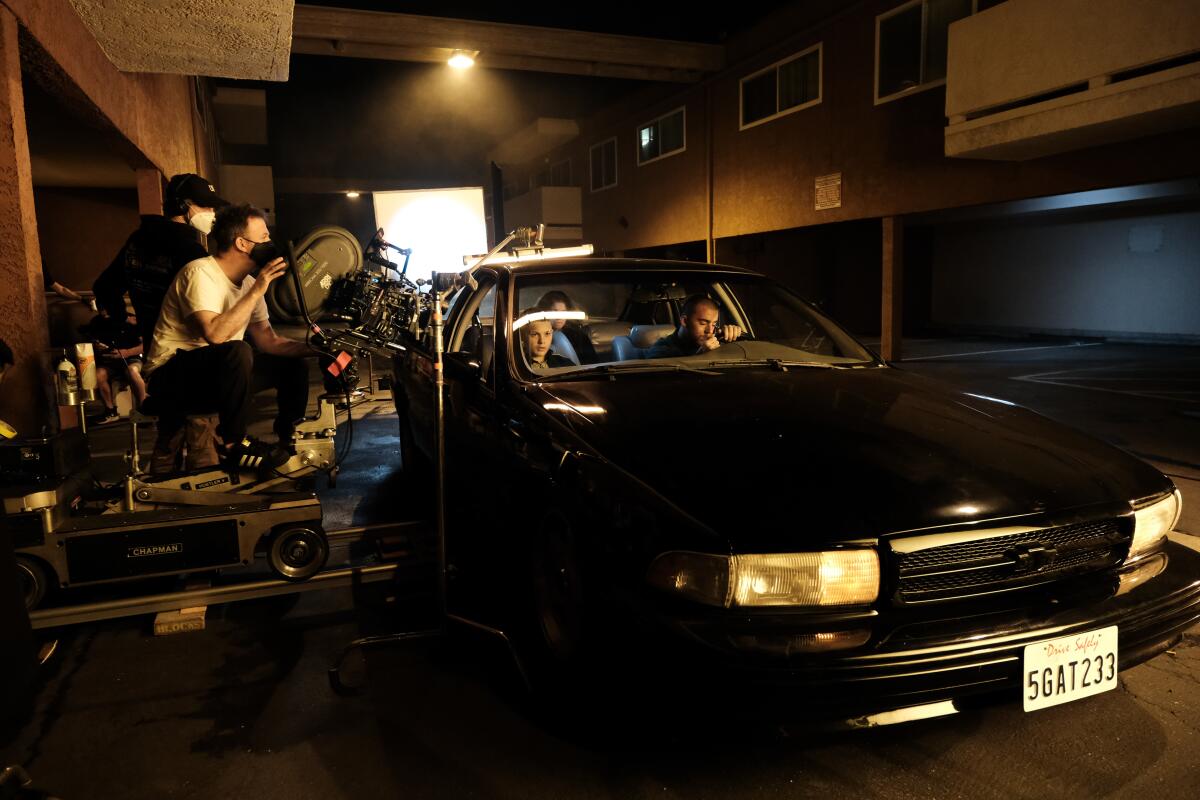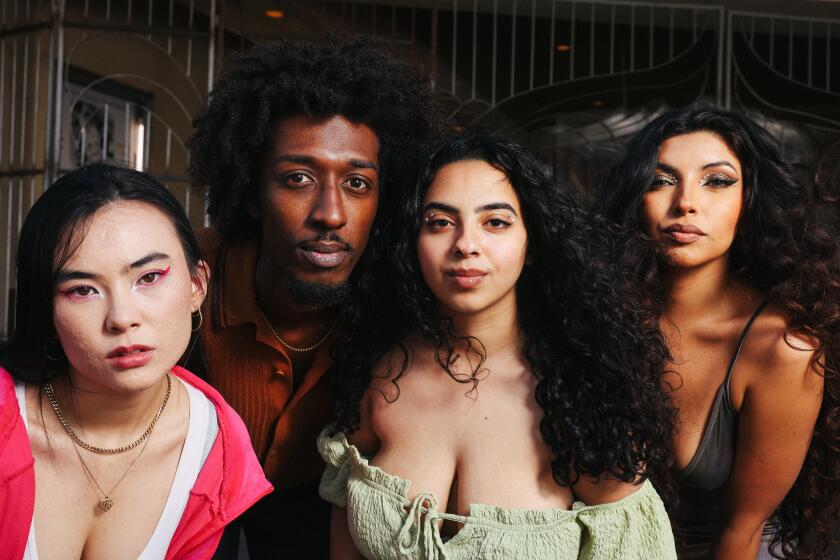Shifting points of view and camera angles create a chaotic precision for ‘Euphoria’

- Share via
The “Euphoria” kids are older but no wiser in the teen drama’s second season, and cinematographer Marcell Rév was determined to reflect that.
“The first thing I wrote down after talking with Sam [Levinson, the HBO series’ producer/writer/director] about Season 2 was ‘every scene or image should feel like a piece of broken memory, an echo of something we wish or imagine,’” Rév says via video call while visiting his native Hungary. “‘It has to have a feeling of incompleteness, something distant, fractured but familiar.’”
That aesthetic reaches its exponential extreme in the season’s penultimate episode, “The Theater and Its Double,” for which Rév has been Emmy nominated. In it, East Highland High School’s sole “good” girl, Lexi (Maude Apatow), presents her semiautobiographical stage play “Our Life” to a packed auditorium. Her best pal Rue (Zendaya), sister Cassie (Sydney Sweeney), idol Maddy (Alexa Demie) and insecure jock Nate (Jacob Elordi) are among those amused or outraged as they watch classmates act out their drug-addled, sex-charged personal dramas.
Rév’s cameras make emotionally loaded moves between the action onstage, reactions in the seats, past incidents that inform “Our Life” and events taking place off campus.
“We tried to blend these things together in a way that still makes sense, but you can’t always decide where you are at the moment,” Rév says. “For example, we used camera moves to connect scenes in Rue’s bedroom to what you realize is not her bedroom, but a set on the theater stage, and then she’s watching the scene unfold from the audience. Another similar trick was the mirror gag, when you think you’re in Cassie and Lexi’s bathroom; we push through the mirror onto the stage and look at Lexi from behind as she talks to the audience.”
Rév employed more mirrors for a Magritte-inspired shot of Nate looking at the back of his head, one of several fine-art references scattered throughout the season (Rév studied at Budapest’s University of Theatre and Film Arts, where he took a master class from the late Vilmos Zsigmond). Frantic business backstage was inspired by Bob Fosse’s 1969 “Sweet Charity” movie; like everything at EHHS, that was filmed on sets built with camera movement in mind at the Lot in West Hollywood. Those remarkably energetic, sometimes noirishly lit traveling shots were done with dollies, cranes and handheld cameras. Despite the chaotic precision achieved in scenes like these, no Steadicams were used during the season.
Life on the set of ‘Euphoria’ isn’t as dramatic as life in ‘Euphoria.’ But for four Season 2 background actors, there was plenty to be ‘hyped’ about.
The season’s most talked-about visual gambit was shooting it all on 35-millimeter film stock, specifically Vision3 500T and Ektachrome reversal that Levinson and Rév talked Kodak into reviving. The weird colors and contrasts that emerge when Ektachrome is cross-processed (like negative stock) proved perfect for the glitchy memory flashbacks that are so much a part of Season 2.
For this episode, though, Rév employed Ektachrome sparingly, primarily for scenes in soulful drug dealer Fezco’s (Angus Cloud) tungsten-lit home and traumatic flashbacks Lexi has of times the sisters spent with their drunken father. The stage show had to be shot on faster, more sensitive Vision3.
“Stage lighting has a more direct, harder quality for the most part,” Rév notes. “A lot of follow spots, profile lights or spotlights hitting actors’ faces, which you are not really used to in contemporary cinema. But I really enjoyed that freedom to go in and do some rougher lighting. It’s a little more old school.”
Rév’s cameras also took a classical approach to the play’s big, climactic production number, which saw underclad boys gyrating around a gym set to Bonnie Tyler’s “Holding Out for a Hero.”
“To be honest, that was the most straightforward part of this episode for us,” Rév says. “We got the choreography from Ryan (Heffington, also Emmy nominated for this season) early on, and we just wanted to be in the right spots at the right angles with the right camera moves for every beat of it, to make it as spectacular and fun as it can be.”
OK. But there must have been tricks to filming the show-stopping arrival of a giant, punching-bag penis, right?
“Yeah,” Rév concedes. “We really needed that foreground; coming into it from above, blocking the actor with it then cutting to the wide shot and revealing what it is. It’s the way you tell a joke, giving some suspense to it and then revealing the gag. It’s how I think a good TV director would direct this thing. Probably they wouldn’t have three days and the resources I did to do it, but a live TV director would do it somewhat like this.”
Rév’s pretty modest for a guy whose work is often considered the most artistic on television.
“Sam and I have a good shorthand,” he says. “Also, it’s a dream relationship for a DP. He involves me as soon as he knows what he’s up to, I get to learn about the project before he writes it. And of course, he’s a very visual director. Some of what people probably credit to me is sometimes already in the scripts.
“We get most of the resources we ask for, we shoot what we like, it’s fun to shoot it, it’s a good set I work on with a lot of very talented people. And I’m nominated for an Emmy? What more could I ask for?”
More to Read
From the Oscars to the Emmys.
Get the Envelope newsletter for exclusive awards season coverage, behind-the-scenes stories from the Envelope podcast and columnist Glenn Whipp’s must-read analysis.
You may occasionally receive promotional content from the Los Angeles Times.











